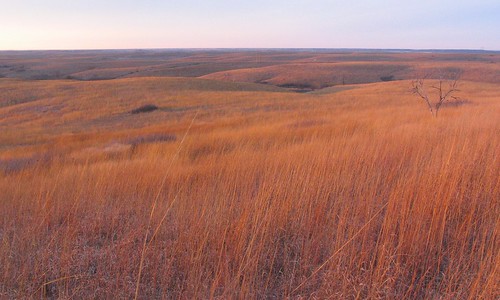
Sunset on the Grass 5: Flint Hills, Kansas: photo by Dennis Toll, 2008
The big bluestem has roots six feet deep.
Indian grass grows with the bluestem;
switch grass also ripples there in the wind.
Going west you get less rain:
the little bluestem grows waist high, and so does
the side oats grama, and the bearded needlegrass.
Further west, the short grass of the Plains grows:
the blue grama, knee high; and the buffalo
grass, which grows up to the ankles.
2 comments:
Puts back in my mind a book I read more than half-a-century ago called "The Death of Grass".... John Christopher. Around the time of the John Wyndham (Day of the Triffids... etc.) books.
Tom,
Useful reference to the 1956 Christopher novel, in which the world is overwhelmed by a virus that kills off all the grasses... and the breakdown of civilization-as-known soon follows. Somewhat more plausible, when you think of it, than an invasion of giant sunflowers from outer space.
In the nineteenth century Robert Louis Stevenson wrote of his train journey across the then still nearly pristine Plains in tones of awe and wonder: "We were at sea...it was a world almost without feature; an empty sky and an empty earth; front and back, the line of railway stretched from horizon to horion, like a cue across a billiard board."
Grasses would have to be the most underappreciated and unseen of the great North American landforms--moving from the tallgrass prairies of the Eastern plains to the shortgrass prairies of the West, they are the central feature as well as the blind spot in a vast and ancient landscape. The hugeness of the sky above is defined by the platform they comprise.
By the by, this post is again a silent nod to Ed Dorn (who actually once sang it, accompanied by the country slide guitar master Richard "Dobro Dick" Dillof, at the MLA Convention in Houston). Ed and I covered this ground together. A significant education. A native of the Eastern fringes of high grass country, Ed was also a lifelong close observer of the Western stretches beyond.
I began to understand something of the beauty and history of this world of grasses in the late 1970s
when we made that High Plains tour. At the time of our survey the Plains had been the staging ground of a a long human war against nature: buffalo hunters, sodbusters, ranchers overgrazing, humid-country farmers extracting the last water from arid soils, mining aquifers, slaughtering species. At the time of our voyage the great industrial farce of strip mining the region for coal, oil-shale and uranium was further extending the damage. Latterly the calamitous droughts of the past decade have continued the depletion. Yet the grasses in many places do survive and remain hardy.
Of course the battle goes on. It is fortunate for Christopher's hero in The Death of Grasses that he has a friend in the Ministry of the Environment with access to classified information, as well as a family farm to escape to in Cumbria. But the disaster scenario of the book remains oddly current. "For years now we've treated the land like a piggy bank, to be raided"--that sounds about right, a half century later.
Post a Comment